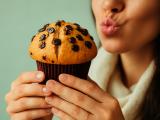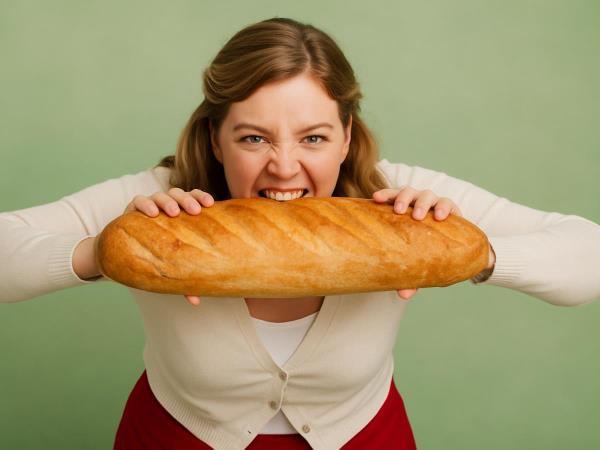But let’s take things step by step...
Bread and Weight Loss: Why How You Eat It Matters
The numbers from studies are clear: bread affects our weight, but the problem isn’t the bread itself—it’s how your body digests it. According to research from Oxford Brookes University, the glycemic index (the figure that shows how quickly food is converted into sugar in your blood) varies greatly. It matters whether you freeze bread, thaw it, or toast it. The difference can be as much as 40%, meaning the same slice of bread can sometimes act as a quick source of energy, and other times as food that keeps you full longer.
Scientist Dr. Sangeetha Thondre explains that freezing bread changes the starch into what’s called resistant starch, which the body doesn’t digest quickly. Instead, it moves more slowly through your digestive tract and at the same time feeds the good bacteria in your intestines. This is good because slower digestion means fewer spikes in blood sugar and less chance that excess sugar will turn into fat.
Dr. Michael Mosley, known to many from BBC health shows, says that resistant starch not only helps with weight management, but also nourishes gut bacteria, which help keep us energized, in a good mood, and even improve our digestion. When your gut has enough good bacteria, you feel more lively. It’s much like having a cup of warm tea in the morning and sensing the day will be great.
Frozen Bread: An Unexpected Ally for Weight Loss
When you freeze bread, you actually outsmart it. The starch molecules change and become more solid. Your body can’t use them instantly, so your blood sugar rises more slowly. According to a study published in the European Journal of Clinical Nutrition, freezing and then thawing bread can lower the blood sugar response almost as effectively as a post-lunch walk.
This means that even with such a simple trick as storing bread in the freezer, you’re doing something good for your waistline and health.
And if someone tells you that fresh bread is the best for weight loss, it’s a myth. It’s not true! Fresh bread may be tasty, softer, and more tempting, but it makes you hungry again more quickly. Why? Because your blood sugar rises and falls faster. It’s similar to eating a spoonful of honey: first, you get a burst of energy, but then you feel tired and want to eat again.
Toasted Bread: 25% Lower Blood Sugar Spike
If you toast bread, the starch partially changes as well. Data from studies shows that toasted fresh bread causes a 25% lower increase in blood sugar than completely fresh bread. And if you freeze it first, then thaw and toast it, this effect increases to almost 40%.
But Be Careful: Bread should be toasted to a golden yellow shade. Once it’s dark brown or black, acrylamide forms—a substance tied by scientists to a higher risk of cancer, which forms at high temperatures. The U.S. Food Safety Agency says it’s best to stick to golden.
Fresh Bread: A Good Choice, But in Moderation
Nutritionist Sarah Schenker highlights that fresh bread contains more moisture, which can help your body absorb iron, calcium, and B vitamins better—like niacin (vitamin B3, important for skin and energy), and thiamine (vitamin B1, helps the nervous system). Fresh bread is also gentler on the stomach as it has less resistant starch and is thus easier to digest. This is good news for people with sensitive stomachs or those struggling with bloating. However, research shows that fresh white bread, which is highly industrially processed, is not the best option. A large study from 2020 to 2024 showed that regular consumption of highly processed white bread increases the risk of obesity and type 2 diabetes by 30–40%.
That’s why it’s better to buy fresh bread from a bakery, made simply (just flour, water, salt, and yeast), without a long list of ingredients. The more ingredients bread has, the worse it is!
Stale Bread: A Natural Probiotic?
Maybe you’ve seen a grandfather say that old bread is better because it’s more honest. Although that sounds like a joke, there’s actually a lot of truth to it. Australian scientists found that white bread left to sit for a week develops more resistant starch. This means it feeds the good bacteria in your gut more. And good bacteria are like little workers. They create short-chain fatty acids (fats the body quickly uses for energy) from food, which protect the gut and signal to the brain that you are full. That’s why people who eat more resistant starch often eat less.
Various studies even mention a 15% lower risk of colon cancer in people who regularly eat foods rich in resistant starch.
Traditional Home Tricks
Our grandmothers didn’t have laboratories, but they had good instincts and home solutions:
- They often let bread dry out a bit or left it overnight so it wasn’t too fresh.
- They used sourdough, which acts as a natural probiotic.
- They ate bread with vegetables or soups, slowing down the digestion of starch.
- They always ate bread with something that gave long-lasting energy (eggs, butter, garlic, olive oil). This isn’t just about taste, but also wisdom: fats and proteins help keep blood sugar from bouncing around like a ball on a playground.
How to Eat Bread So It's Kind to Your Body
The most important rules, confirmed by both scientists and tradition, are:
- If you want more stable blood sugar and to feel full longer, freeze your bread, thaw it, and toast it.
- If you have a sensitive stomach, fresh bread might be easier for you, but don’t overdo it. One slice a day is enough.
- If you want to feed your good bacteria, eat slightly stale bread or sourdough bread.
- Avoid burnt bread.
- Eat bread with proteins and healthy fats (yogurt, eggs, cheese, avocado, olive oil).
- Don’t be afraid of homemade sourdough breads. Studies from 2023 show they’re better for digestion and satiety.
Bread Isn’t the Enemy If You Know How to Eat It
In the years after 2020, many people switched to breadless diets because they believed bread was the main culprit in weight gain. But the truth is simpler and kinder: bread isn’t the problem—the problem is how and how much of it we eat.
Bread has been with us for thousands of years. If it’s made and eaten the right way, it can be part of a healthy life, not an obstacle. With a bit of science, some traditional wisdom, and your own intuition, every bite can become an aid to your health, not an enemy.









 Would you like to be informed about news on the website?
Would you like to be informed about news on the website?

